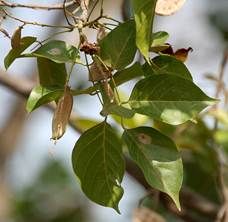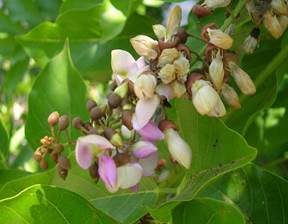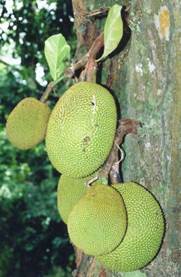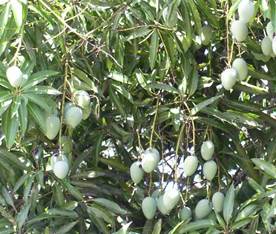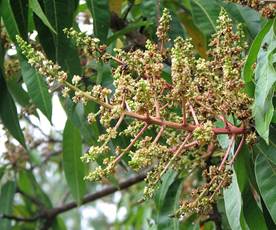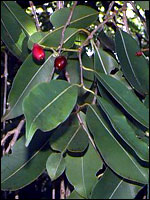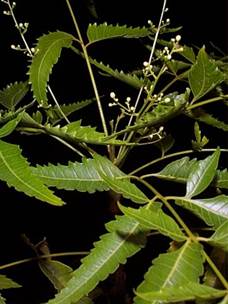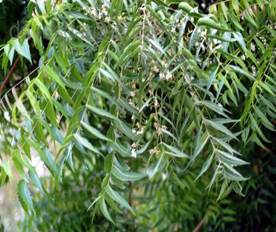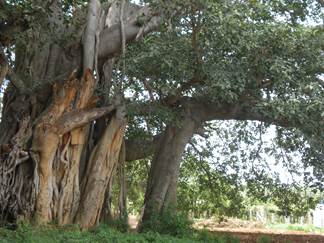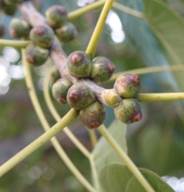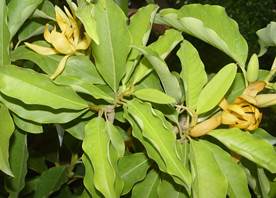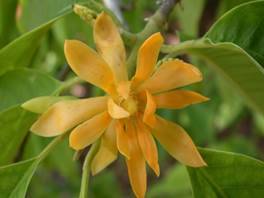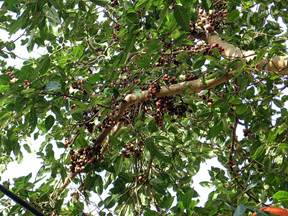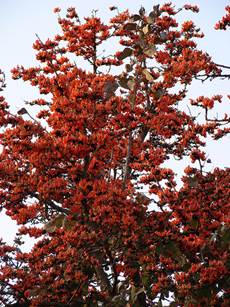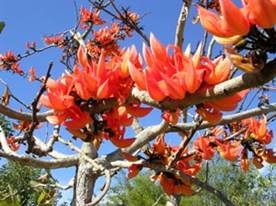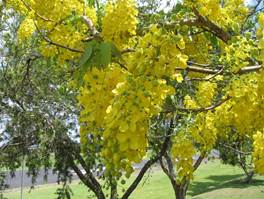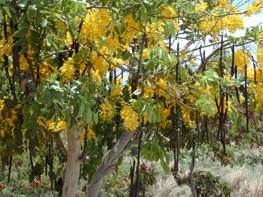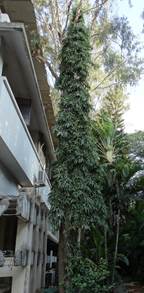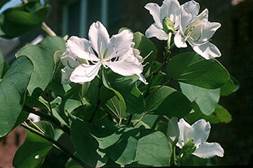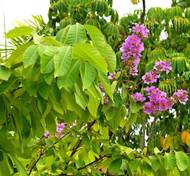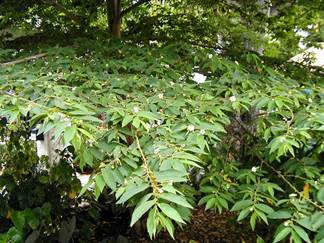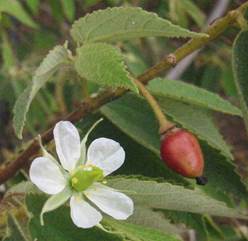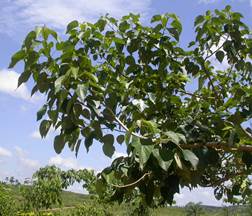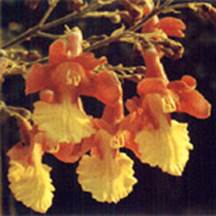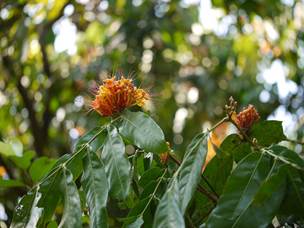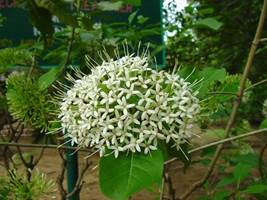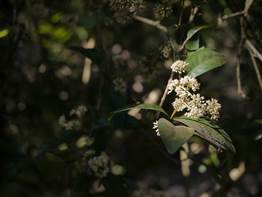Description of the trees suggested for planting at the Sides and Median of the Roads in Bengalore
Bengaluru / Greater Bangalore / Bruhat Bengaluru / Bangalore (77°37’19.54’’ E and 12°59’09.76’’ N) is the principal administrative, cultural, commercial, industrial, and knowledge capital of Karnataka state. Bangalore city’s population has increased enormously from 6,537,124(in 2001) to 9,588,910 (in 2011), amounting to a decadal growth of 46.68%. With this, the population density has increased from as 10,732 (in 2001) to 13,392 (in 2011) persons per sq. km. The vegetation of Bangalore was classified as dry deciduous forest-type under the Terminalia-Anogeissus latifolia-Tectona series. The city had enjoyed salubrious climate throughout the year prior to the industrialization era. Land use analysis based on the fusion of Resourcesat-2 MSS data with Cartosat 2 shows that the spatial extent of tree vegetation in Bangalore is 100.02 sq.km (14.08%).
Urban vegetation includes trees, shrubs and herbs on public and private lands (parks, streets, backyards), all interspersed within a landscape dominated by paved surfaces. This kind of vegetation plays a vital role in moderating micro climate, sequestering greenhouse gases (CO2, etc.) and also in aiding the percolation of water. Estimates indicate that about 6 tons of carbon is sequestered by 1 hectare of forests annually and this averages out as the carbon sequestration of 6 kg/tree/year. Per capita respiratory carbon ranges from 192 to 328 kg/year depending on the physiology of humans. Generally, the carbon dissipated through respiration varies from 525 to 900 gm/day/person. This means 32 to 55 trees per person in a region is required to exclusively mitigate respiratory CO2.
Maintenance of green cover is the need of the hour in urban areas with increase in paved surfaces due to urbanisation. Selection of plant species for planting at the sides and median also require utmost care. Exotic species flower greatly, but fail to stand during harsh wind and after certain age the strength of the root fails to hold the tree to the soil, and hence fall during monsoon, which creates major problem. In the past and also traditionally, native tree species were being selected for avenues and also at the fringes, which are quite strong, provides fruits and shade for the needy. These native tree species are a source of nectar, food for several species of birds and insects. In this regards, it is suggestible to plant native tree species at the sides and the median of ring roads. Median of the roads needs smaller trees that do not obstacle the movements of vehicles and do not cause problem further. Hence, selection of the plant species for median of the roads is also important. The following section, lists the tree species to be considered for planting along road sides and median.
Description of the trees suggested for planting at sides of the roads:
1. Pongamia pinnata (Honge Mara)
Description:
It is a deciduous tree that grows to about 15-25 meters in height with a large canopy of leaf cover that spreads equally wide. The leaves are a soft, shiny burgundy in early summer and mature to a glossy, deep green as the season progresses. Small clusters of white, purple, and pink flowers blossom on their branches throughout the year, maturing into brown seed pods. The tree is well suited to intense heat and sunlight and its dense network of lateral roots and its thick, long taproot make it drought tolerant. The dense shade it provides slows the evaporation of surface water and its root structures promote nitrogen fixation, which moves nutrients from the air into the soil.
Local names: Indian Beech, Pongam, Honge, Ponge, and Karanj
Flowers and Fruits: summer

2. Artocarpus heterophyllus (jackfruit)
Description: A tree with milky latex well suited to tropical lowlands. The leaves are dark green, leathery and shining. Its fruit is the largest, seldom less than about 25 cm (10 in) in diameter. Even a relatively thin tree, around 10 cm (4 in) diameter, can bear large fruit. The jackfruit is something of an acquired taste, but it is very popular in many parts of the world. The sweet yellow sheaths around the seeds are about 3–5 mm thick, but milder and less juicy.
Local names: Jack fruit; Katahal
Flowers and fruits: Summer

3. Mangifera indica (Mango trees)
Description:
Grows to 35-40 m in height, with a crown radius of 10 m. The leaves are dark green, alternate, simple, 15-35 cm long and 6-16 cm broad; when the leaves are young they are orange-pink, rapidly changing to a dark glossy red, then dark green as they mature. The flowers are produced in terminal clusters 10-40 cm long; each flower is small and white with five petals 5-10 mm long, with a mild sweet odor. After the flowers finish, the fruit takes from three to six months to ripen. The ripe fruit is variable in size (right image) and color, such as yellow, orange, red or purple.
Local names: Mango, Aam
Flowers and fruits: Winter to Summer

4. Syzigium cumini (Jamoon)
Description:
An evergreen tropical tree 50 to 100 ft. tall, with oblong opposite leaves that are smooth, glossy; they have a turpentine smell. The bark is scaly gray and the trunk forks into multiple trunks about 3 - 5' from the ground. Jamun has fragrant white flowers in branched clusters at stem tips and purplish-black oval edible berries. The juicy fruit-pulp contains resin, gallic acid and tannin; it tastes usually from acid to fairly sweet. The somewhat astringent, jamun fruit can be utilized for juice. This berry has only one seed.
Local names: Java plum, jamun, black plum, Indian blackberry
Flowers and fruits: Winter to summer

5. Azadirachta indica (Neem)
Description:
A fast growing tree that can reach a height of 15-20 m (about 50-65 feet. The branches are wide spread. The fairly dense canopy may reach the diameter of 15-20 m in old. The trunk is relatively short, straight and may reach a diameter of 1.2 m. The bark is hard, fissured or scaly, and whitish-grey to reddish-brown. The sapwood is greyish-white and the heartwood reddish when first exposed to the air becoming reddish-brown after exposure. The root system consists of a strong taproot and well developed lateral roots. The flowers (white and fragrant) are arranged more-or-less drooping clusters which are up to 25 cm long. The fruit is a smooth drupe which varies in shape from elongate oval to nearly roundish.
Local names: Neem, Bevu
Flowers and fruits: Winter to summer

6. Ficus bengalensis (Banyan)
Description:
The Banyan is a tree with a huge spread with characteristic aerial roots which upon touching and entering the earth, draws sustenance from the earth, thickens/lignifies and becomes a new trunk. The vine like aerial roots plunging down from the main limbs of the tree form a network of trunks with surface roots spreading in all direction. The leaves are leathery and oval shaped with the berry or figs emerging in pairs which are globose and ripen to a red colour. Typically the flowers – male and female and gall flowers all grow radially inwards towards the centre of the hollow berry or fig. The tree is evergreen though briefly leafless at the peak of the hot season in dry localities.
Local names: Banyan, Nyagrodha, Bargad, Aladha mara
Flowers and fruits: Throughout the year

7. Ficus religiosa (Sacred Fig,Pipal)
Description:
It is a large dry season-deciduous tree up to 30 m tall and with a trunk diameter of up to 3 m. The leaves are heart shaped with a distinctive extended tip; they are 10-17cm long and 8-12cm broad, with a 6-10cm petiole. The fruit is a small fig 1-1.5cm diameter, green ripening purple. This plant is considered sacred by the followers of Hinduism, Jainism and Buddhism, and hence the name 'Sacred Fig' was given to it. Siddhartha Gautama is referred to have been sitting underneath a Bo Tree when he was enlightened (Bodhi), or "awakened" (Buddha).
Local names: Bodhi, Pipal (peepal, peepul, pippala, pimpal, etc.), arali or Ashvastha
Flowers and fruits: December to March

8. Michelia champaca (Champak)
Description:
This small tree has alternate, lanceolate leaves to over 20 cm long that are slightly curved. The flowers are fragrant, a mustard yellow colour, and in each flower the ovaries are free from one another. The central stalk or receptacle elongates and bears the developing fruits along it. When fully developed each individual fruit is about 2.5 cm long, with a reddish tinge and whitish pustules; this follicle opens to release orange-red seeds.
Local names: champaka, champak or champac, champa, sampige and shamba
Flowers and fruits: December to April

9. Ficus racemosa (Fig)
Description:
Tree growing up to 10-16m tall with grayish bark. Leaves are 7.5-10cm long, ovate or elliptic in shape, dark green. Flowers are in the form of fruit, visible when cut open. The fruit in large clusters, arising from main trunk or large branches.
Local names: Indian Fig, Atthi mara, Udumbara
Flowers and fruits: Throughout the year

10. Butea monosperma (Flame of the forest)
Description:
It is a medium sized dry seasondeciduous tree, growing to 15 m tall. Theleaves are pinnate, with an 8-16 cm petiole and three leaflets, each leaflet 10-20 cm long. The >flowers are 2.5 cm long, bright orange-red, and produced inracemes up to 15 cm long. The fruit is a pod 15-20 cm long and 4-5 cm broad. It is said that the tree is a form of Agnidev, God of Fire. It was a punishment given to Him byGoddess Parvati for disturbing Hers and Lord Shiva's privacy.
Local names: Flame of the forest, Mutthuga, Kinshuk, Palash, Dhak
Flowers and fruits: January to May

11. Cassia fistula (Golden Shower Tree
Description:
It is a medium-sized tree growing to 10-20 m tall with fast growth. The leaves are deciduousor semi-evergreen, 15-60 cm long, pinnate with 3-8 pairs of leaflets, each leaflet 7-21 cm long and 4-9 cm broad. The flowers are produced in pendulous racemes 20-40 cm long, each flower 4-7 cm diameter with five yellow petals of equal size and shape. The fruit is a legume is 30-60 cm long and 1.5-2.5 cm broad, with a pungent odour and containing several seeds.
Local names: Kakke mara, suvarnaka, bendra lathi, golden shower, Indian laburnum
Flowers and fruits: March to May

12. Polyalthia longifolia
Description: It is erect tree up to 4 m high. Leaves alternate, narrow-lanceolate, simple, shortly-petiole, acute, shining. Inflorescence a panicle, sometimes in a short-peducled umbel, sepals 3, free, triangular, apex reflexed. Fruit a berry, ovoid, reddish black, seeds smooth.
Local name: Ulkat, Kastadaruha (Sankrit); Debdari, Ashoka (Hindi); Madras Ashoka (Kannada)
Flower, Fruit: March – April

13. Bauhinia variegata
Description:
It attain moderate sized tree upto 6 m high. Leaves alternate, simple, coriaceous, cordate. Inflorescence corymbose raceme, terminal or axillary. Petals ovate-oblong, clawed, prominently nerved, usually one of them brightly coloured. Fruit a pod, flat, glabrous, prominently veined when dry dehiscent.
Local name: Kanchanara (Sanskrit), Kachnar (Hindi), Kempu mandara (Kannada)
Flower, Fruit: November – February

14. Lagerstroemia speciosa (Pride of India)
Description:
A medium size handsome deciduous tree. Leaves are simple, large, elongate, elliptic, short-stalked that turn red before falling. The rose-like flowers (about 4.5-5 cm. across) with crinkly petals and numerous stamens are most attractive and are displayed on large, erect clusters at branch ends. Fruits are woody, spherical (about 2 cm. dia.) and dehisce into a fruit-cup-like structure with five or more spreading lobes of the fruit wall. Bark is pale-brown, smooth or flaking thinly.
Local name: Pride of India, Queen Crape Myrtle (English), Jarul (Hindi)
Flower, Fruit: March-June
Description of the trees suggested for planting at median of the roads:
1. Muntingia calabura (Singapore cherry)
Description:
It is a small tree 7-12 meters tall with tiered and slightly drooping branches. It has serrated leaves 2.5-15 cm long and 1-6.5 cm wide. The flowers are small and white, gives rise to 1-1.5 cm light red fruit. The fruit is edible, sweet and juicy, and contains a large number of tiny (0.5 mm) yellow seeds. It is a pioneer species that thrives in poor soil, able to tolerate acidic and alkaline conditions and drought. Its seeds are dispersed by birds and fruit bats. It is cultivated for its edible fruit, and has become naturalised in some other parts of the tropics, including southeastern Asia.
Local names: Gasgase hannu, Singapore cherry
Flowers and fruits: Throughout the year

2. Gmelina arborea (Gamhar, Shivani)
Description:
The tree attains moderate to large height up to 30 m with girth of 1.2 to 4.5 m with a clear bole of 9-15 m. It has a smooth whitish grey (ashy) corky bark, warty with lenticular tubercles exfoliating in regular patches when old. It is a treat to see the tree standing straight with clear bole having branches on top and thick foliage forming a conical crown on the top of the tall stem. Flowers are bright yellow coloured and attractive. The bark is light grey coloured, exfoliating in light coloured patches when old, blaze thick, a chlorophyll layer just under the outer bark, pale yellow white inside. wood is pale yellow to cream coloured or plukish-buff when fresh, turning yellowish brown on exposure and is soft to moderately hard, light to moderately heavy, lustrous when fresh, usually straight to irregular or rarely wavy grained and medium course textured.
Local names: gambar, khumbhari, kumbuda, kumulu, shivani
Flowers and fruits: February to April

3. Saraca asoca (Sita Ashoka Tree)
Description:
The tree attain moderate height up to 7 m high. Bark pink-brown, relatively smooth, but inconspicuously and irregularly fissured. Leaves are large, compound, and alternate with strap-like leaflets. Flowers are 1.5 to 2 cm long, attractive and clustered in axillary inflorescences. Fruit is a few-seeded oblong pod.
Local name: Ashok, Anganapriya, kenkalimara (Kannada)
Flower and fruit: March to August

4. Pavetta indica (Paapate gida)
Description:
It is an erect, nearly smooth or somewhat hairy shrub 2 to 4 meters or more in height. Bark grey, smooth and irreuarly scaly when mature; blaze greenish cream. The leaves are elliptic-oblong to elliptic-lanceolate, 6-15 cm long, and pointed at both ends. The flowers are white, rather fragrant, and borne in considerable numbers in hairy terminal panicles. The sepals are very small, and toothed. The flower-tube is slender and about 1.5 cm long, with obtuse petals about half the length of the tube. The flowers attract butterflies and insects. The fruit is black when dry, and about 6 mm in diameter.
Common name: Indian Pavetta, Indian Pellet Shrub, Kankara, Kathachampa (Hindi), Pavati (Kannada).

5. Ixora brachiate
Description:
It is a small tropical tree found in evergreen forests of southern parts of India, attain to 10 m tall. Oppositely arranged leaves, 14-16 x 3.5-6.5 cm, are elliptic-oblong or elliptic-obovate, with obtuse tip and acute base. Flowers are white, small, sessile, and fragrant, in terminal panicled cymes. The branches of the clusters are red in color and the flowers are tiny white. Flower tube is 5-6 mm long, narrow, with petals 2 mm long, oblong, bent abruptly backward. Berry, globose, 0.6 cm long, reddish when ripe.
Local name: Gorbale (Marathi)
Flowering: December-February.

6. Nyctanthes arbor-tristis (Parijata)
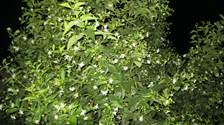
Description:
Nyctanthes arbor-tristis is a shrub or a small tree growing to 10 m tall, with flaky grey bark. The leaves are opposite, simple, 2–6.5 cm broad, with an entire margin. The flowers are white corolla woth an orange-red centre, five to eight lobed and fragrant, they are produced in clusters of two to seven together, with individual flowers opening at dusk and finishing at dawn. The fruit is a heart-shaped to round capsule 2 cm diameter, with two sections each containing a single seed.
Common name: Har singar, Coral Jasmine, Tree of Sorrow, Queen of the night, Har singar, Paarijat (Hindi)

7. Gardenia gummifera
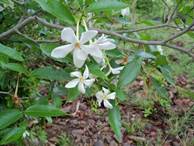
Description:
It is a small tree which grows up to 3 meters. They are evergreen shrubs and small trees growing to 1-15 m tall. The leaves are 5-50 cm long and 3-25 cm broad, dark green and glossy with a leathery texture, opposite or in whorls of three or four, calyx up to 1 cm long, pubescent, teeth 5-6, short, triangular. Corolla-tube 2.5 – 5 cm long, white, turning yellow. Berry ellipsoid or oblong upto 4 cm long striate, crowned with the persistent calyx.
Flower: March – May
Local name: Naadihingu (Sanskrit), Dikamali (Hindi), Bukki gida (Kannada)

8. Ervatamia heyneana (Nandi batlu gida)
Description:
A small deciduous tree with white flowers and orange-yellow follicles, the seed arils red. Bark grey, wood white and pale grey in streaks, smooth, moderately hard. Leaves elliptic-oblong or lanceolate, shortly acuminate at apex. Corolla- tube thick 8-1 in. long dilated at top, calyx-lobes obtuse or emarginated, thick,
Local name: Nag kuda



